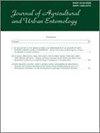Acaricidal Effects of Silicon Oxide and Zinc Oxide Nanoparticles against Tetranychus urticae (Acari: Tetranychidae) on Tomato Plants
Q2 Agricultural and Biological Sciences
引用次数: 2
Abstract
ABSTRACT The twospotted spider mite, Tetranychus urticae Koch (Acari: Tetranychidae), is one of the world's most damaging agricultural pests. Nanoparticles have become one of the most promising new tools for pest management in recent years, but their efficacies against T. urticae are poorly known. We conducted laboratory and greenhouse experiments to evaluate the efficacy of commercially available silicon oxide nanoparticle (SiO-NP) and zinc oxide nanoparticle (ZnO-NP), each applied at 5, 50 and 100 ppm, on the adult and egg stages of T. urticae on tomato, Solanum lycopersicum L. (Solanaceae). In the laboratory experiment, SiO-NP and ZnO-NP at 100 ppm caused 100% mortality among female adult mites at 72 h after treatment and among eggs at 7 d post-treatment. In the greenhouse experiment, SiO-NP and ZnO-NP at 50 and 100 ppm caused withered plants, whereas treatment at 5 ppm did not cause any phytotoxicity and decreased mite densities to 0.25 adult/leaf and 0.4 egg/leaf on SiO-NP-treated plants and 0 adult/leaf and 0.3 egg/leaf on ZnO-NP-treated at 7 d post-treatment. Mite densities at 7 d post-treatment were 1.8 adult/leaf and 1.7 egg/leaf on untreated plants. Average percentage of leaf area damaged was 25% on the untreated plants, and 0.7% and 0.9% on plants treated with SiO-NP and ZnO-NP at 5 ppm, respectively. These results suggest that application of SiO-NP and ZnO-NP at 5 ppm can be used as eco-friendly management strategy of T. urticae.氧化硅和氧化锌纳米颗粒对番茄二叶螨的杀螨作用
摘要二斑叶螨是世界上危害最严重的农业害虫之一。近年来,纳米颗粒已成为最有前途的害虫管理新工具之一,但其对荨麻疹的疗效却鲜为人知。我们进行了实验室和温室实验,以评估市售氧化硅纳米颗粒(SiO NP)和氧化锌纳米颗粒(ZnO NP)在番茄茄科(Solanaceae)上的成体和卵期的功效。在实验室实验中,100ppm的SiO-NP和ZnO-NP在处理后72小时对雌性成年螨和处理后7天对卵造成100%的死亡率。在温室实验中,50和100ppm的SiO-NP和ZnO NP引起植物枯萎,而5ppm的处理没有引起任何植物毒性,并且在处理后7天,SiO-NP处理的植物上的螨密度降低到0.25成虫/叶和0.4卵/叶,ZnO NP处理的植物的螨密度降到0成虫/叶,0.3卵/叶。在未处理的植物上,处理后7天的螨密度为1.8成虫/叶和1.7卵/叶。未处理的植物的平均叶面积受损百分比为25%,用5ppm的SiO-NP和ZnO-NP处理的植物分别为0.7%和0.9%。这些结果表明,施用5ppm的SiO-NP和ZnO-NP可以作为对二斑蝶的环保管理策略。
本文章由计算机程序翻译,如有差异,请以英文原文为准。
求助全文
约1分钟内获得全文
求助全文
来源期刊

The Journal of Agricultural and Urban Entomology
Agricultural and Biological Sciences-Insect Science
CiteScore
1.40
自引率
0.00%
发文量
2
期刊介绍:
The Journal of Agricultural and Urban Entomology (JAUE) (Journal of Agricultural Entomology, Jan 1984 - Oct 1998 volumes 1-15) is published under the auspices of the South Carolina Entomological Society (SCES). The Journal publishes contributions of original research concerning insects and other arthropods of agricultural and urban importance to include those affecting humans, livestock, poultry, and wildlife. JAUE is particularly dedicated to the publication of articles and notes pertaining to applied entomology, although it will accept suitable contributions of a fundamental nature related to agricultural and urban entomology.
 求助内容:
求助内容: 应助结果提醒方式:
应助结果提醒方式:


